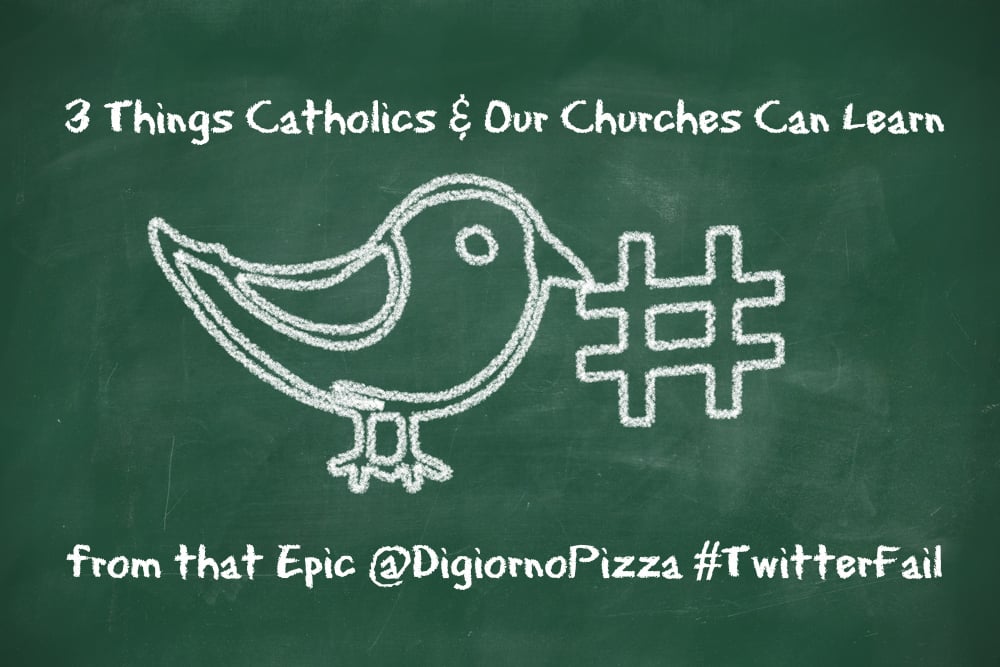 Can we Catholics learn a thing or two from a frozen pizza company that might be useful to us in the New Evangelization?
Can we Catholics learn a thing or two from a frozen pizza company that might be useful to us in the New Evangelization?
Matt Swaim and I would argue “Yes!”
We took on this topic for today’s episode of The Son Rise Morning Show, where I’m blessed to serve as a regular technology contributor. This week, we looked at the recent — and epic — Twitter fail by Digiorno Pizza. You may know them as an upscale frozen pizza manufacturer, but around social media realms they are currently a “go to” example of why we all need to be extra cautious when we employ Twitter to convey information.
On September 8th, the hashtag #WhyIStayed and its counterpart #WhyILeft were trending in a follow up to TMZ’s release of the expanded video showing Janay (Palmer) Rice being knocked unconscious in an elevator by her then fiance (now husband), NFL player Ray Rice. The #WhyIStayed hashtag was intended to promote a serious conversation about domestic violence.
Apparently, the party responsible for Digiorno’s Twitter feed that night decided to piggyback (as brands often do) on a trending topic when it used the hashtag to tweet the message “#WhyIStayed You Had Pizza.” Four words (if you count the hashtag as one), almost immediately deleted when they realized what the hashtag related to, but not before @JayScottSmith grabbed a screen capture of the message:
@Deadspin So ummm…DiGiorno will be in need of a new social media manager. pic.twitter.com/fnhGgg0uB2
— Jay Scott Smith (@JayScottSmith) September 9, 2014
Two weeks later, Digiorno was still apologizing. The incident was featured in Time, Huffington Post, Mashable and other media outlets. It’s tough to estimate the damage done to the brand, but no one wants to be the company who was perceived to make light of something as serious as domestic violence.
So what can we learn from this incident and how can this lesson be applied to our dioceses, parishes, schools and even by ourselves as individuals:
- We can and should be using hashtags in social media to encourage conversation and engagement. Our use of social media tools such as Twitter has vast potential for meeting folks exactly where they are along their path to God and journeying with them. But we should always pray and think and investigate before we “piggyback” on a trending hashtag to spread the Good News of the Gospel.
- Parishes, dioceses, schools, ministries and other organizations who have social media teams must establish and consistently reexamine their protocols and procedures for communicating via social media. What tone do you want in your messages? How much leeway do team members have to be creative in conversing via the official parish or organization social media account? These things should be discussed up front to avoid mistakes.
- WWJT – Yes, I said it. Ask yourself “What would Jesus Tweet?” When we tweet, we are representing our church, even if we do it from our own profiles. For many of my social media connections, I am the only Catholic they may know. My behavior and communication are for them a reflection of my church’s values, mission and message. So my messages in social media must be consistent with the Gospel.
We can likely all point to moments on Facebook or Twitter that make us less than proud. I’ve deleted more than a few messages that should never have been sent. Episodes such as Digiorno’s #epicfail remind me that often silence and prayer are the most profound means of communicating.
Your turn: Have you ever had an #epicfail of your own in social media? What did it teach you?











